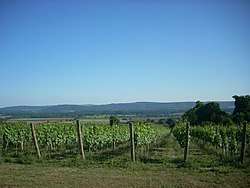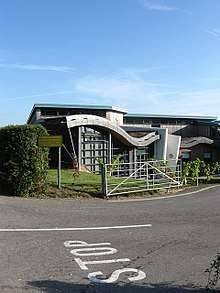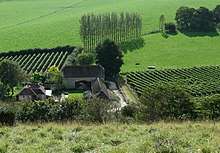Sussex wine
| Wine region | |
 Vineyard close to South Downs in Sussex | |
| Country | United Kingdom |
|---|---|
| No. of vineyards | over 50 |
| Grapes produced | Pinot Meunier, Pinot Noir, Chardonnay, Bacchus, Pinot Blanc and Regent |
| No. of wineries | 23 |
Sussex wine is wine produced in the historic county of Sussex in England, a region divided for administrative purposes into East Sussex and West Sussex. In 2016 wine made in East and West Sussex accounted for about a quarter of the total wine produced in England[1] and with over 50 vineyards Sussex produces more wine than other county in the UK.[2] In 2016 Sussex wine was granted protected regional status by the Department for Environment, Food and Rural Affairs (DEFRA).[1] DEFRA has also applied to the European Union for Protected Designation of Origin status in the European Union’s Geographic Indication scheme.[3]
Sussex's sparkling wine in particular has drawn comparisons with Champagne and is sometimes rated as some of the best in the world.[4][5][6]
History
It is likely that wine has been produced in Sussex for around 2000 years.[7] It is likely that wine was produced either by the late Iron Age tribes such as the Belgae and Regnenses or by the Romans who governed what was to become Sussex.[7][8]
Vineyards in England produced significant amounts of wine in the 12th and early 13th centuries. However this came to an end in the 13th and 14th centuries as the Medieval Warm Period began to end, the Black Death reduced the workforce and wine was increasingly imported from Gascony. By 1275 the vineyard at Battle Abbey had ceased grape production.[9]
The Bolney wine estate was established at Bolney near Haywards Heath in 1972 by Janet and Rodney Pratt, and was one of the first commercial vineyards in England.

Peter Hall planted his vineyard at Breaky Bottom on the South Downs near Lewes in 1974 at a time when there were only a dozen or so growers in the whole country.[10]
Plumpton College is the UK's specialist centre for wine research and training.[11] Its purpose-built wine centre opened in 2014.[12] It is the only establishment in Europe to offer undergraduate degrees in Wine Business and Production taught in the English language.[2]
Geography and climate
The region has a warm climate and soil types similar to the Champagne district which lies on the 49th parallel north while the Sussex Weald lies on the 51st parallel north. Sussex has many south-facing slopes, which are suitable for growing the grape varieties found in sparkling wine, such as Chardonnay, Pinot Noir and Pinot Meunier.[7]
Climate change has also impacted on the climate of Sussex. According to the Met Office 14 out of the 15 warmest summers on record have been in the 21st century. This means that what winemakers can grow in Sussex has changed.[13] In addition, the cooler evenings and cool evening sea breezes[2] in Sussex allows the grapes to develop high levels of natural acidity when fully ripe - crucial for sparkling wine and allowing harvesting to take place in October.[13][14]
Viticulture and grapes
Kingscote Estate near East Grinstead grows Pinot Meunier, Pinot Noir, Chardonnay, Bacchus, Pinot Blanc and Regent grapes on its south-facing slopes.[13] In the 20th century the cooler climate had restricted the varieties of grape that can grow in Sussex to a range of Germanic varieties.[13]
Winemaking and styles
Classification
The application for PDO status is the second in the UK after the Camel Valley in Cornwall[3] was submitted in 2012.[15] Sussex is the first major wine area in the UK to apply. An application for PDO status was submitted to the European Union in 2016. Formal certification could take several years to be agreed by the European Commission.[15] Until the process is ratified by the EU, Sussex wine has temporary protected status in the UK.[15]
Since protected status was given to Sussex wines in 2016, wine producers must meet stringent quality guidelines in order to display the name of the county on their wines.[16] The first wine to be produced under the Sussex PDO scheme was approved in 2016 for Rathfinny estate. [17] PDO status means that all wines using the name 'Sussex wine' have to be produced in Sussex from grapes grown in Sussex.[7]
The idea came from Jamie Everett, chief operating officer of the Rathfinny estate, one of England’s newest (and aiming to be the largest) vineyards in the UK. The consortium, which includes the larger and older vineyards Ridgeview and Bolney estates, has the backing of the UK government. At least half the vineyards have supported the bid to give protected status to wine made from grapes grown in Sussex.
Wineries

Sussex boasts the largest and most densely planted cluster of vineyards (23 in total) in the UK. In 2016 wine made in East and West Sussex accounted for about a quarter of the total produced in England.[1]
The Rathfinny Wine Estate near Alfriston aims to be the largest in England by 2020 and one of Europe's largest vineyards with nearly a million bottles of Sussex Sparkling Wine per year.[18][19]
See also
Bibliography
- Keevill, Graham; Hall, Teresa (2017). Monastic Archaeology: Papers on the Study of Medieval Monasteries. Oxbow Books. ISBN 9781785705670.
References
- 1 2 3 Alexander, Saffron (21 November 2016). "Fancy a glass of Sussex? More English sparkling wine is granted protected regional status". Retrieved 27 June 2017.
- 1 2 3 "The Story of Wine in the South Downs". South Downs National Park Authority. Retrieved 21 July 2017.
- 1 2 Mercer, Chris (22 November 2016). "Sussex wine closer to joining Champagne in Europe's elite club". Decanter magazine.
- ↑ Thompson, Hannah (21 March 2017). "English Wine Sommelier Says Sussex is Better Than Champagne". Big Hospitality.co.uk. Retrieved 21 July 2017.
- ↑ Allen, Peter (21 April 2016). "English Sparkling Wine Beats Champagne in Paris Blind Tasting". The Telegraph. Retrieved 21 July 2017.
- ↑ Loomes, Naomi (4 September 2010). "Sussex Sparkling Wine is World's Best "Champagne"". The Argus. Retrieved 21 July 2017.
- 1 2 3 4 Whatley, Sara (22 April 2015). "A Bottled History of Sussex". Sussex Living magazine. Retrieved 18 July 2017.
- ↑ "The South Downs Story". South Downs National Park Authority. Retrieved 21 July 2017.
- ↑ Keevill & Hall 2017, p. 69
- ↑ "Breaky Bottom Online - History". Retrieved 27 June 2017.
- ↑ Green, Miranda (22 August 2016). "Plumpton College Spreads Global Roots for English Wine Expertise". Financial Times. Retrieved 21 July 2017.
- ↑ Holloway, Henry (26 March 2014). "UK's First Wine Research Centre to Open at Plumpton". The Argus. Retrieved 21 July 2017.
- 1 2 3 4 Southam, Hazel (9 April 2015). "A glass of Sussex". Royal Geographic Society. Retrieved 15 July 2017.
- ↑ James, Ben (12 May 2016). "Ken Clarke: Brexit would be 'extremely damaging' to wine industry". The Argus. Retrieved 15 July 2017.
- 1 2 3 Mileham, Arabella (22 November 2016). "Sussex Wine Step Closer to PDO". The Drinks Business. Retrieved 21 July 2017.
- ↑ Gordon, Amie (21 November 2016). "'Would you like a delicious glass of Sussex?' Wine from the region is just as good as champagne and has been granted protected status". Daily Mail. Retrieved 15 July 2017.
- ↑ Shaw, Lucy (11 September 2017). "Rathfinny First Out of Blocks with 'Sussex' Wine". The Drinks Business.
- ↑ "Rathfinny Media Pack" (PDF) (PDF). Rathfinny Estate. Retrieved 31 July 2017.
- ↑ Smithers, Rebecca (15 March 2015). "Sussex Vineyards in Bid to Put Themselves on Europe's Wine Map". Retrieved 31 July 2017.